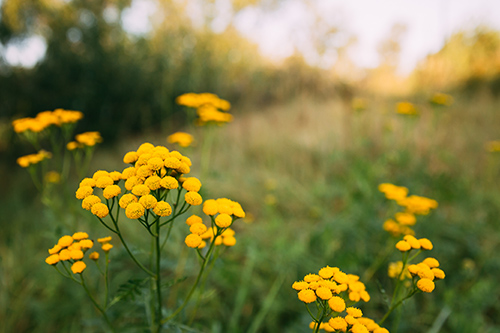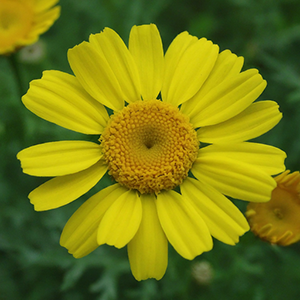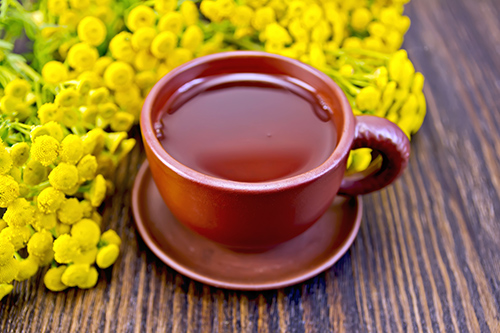Contents
Some of the common names of the tansy plant will immediately give you an idea of its anthelmintic properties. Classical botanists did not know this herb, but it was first mentioned in the 12th century.
- Latin/Botanical Name: Tanacetum vulgare
- Origin: Croatia/Albania
- USDA Certified Organic
- CGMP Compliant (Current Good Manufacturing Practices)
- Kosher Certified by Kosher Certification Services

Healing Properties
The tansy plant contains tannin, flavonoids, and an essence rich in thujone, to which the plant owes its properties.
- Vermifuge – It paralyzes intestinal worms (roundworms and oxyuridae), and although it does not kill them, it promotes their expulsion if a purgative substance is taken after this plant.
- Emmenagogue – Normalizes and produces menstruation.
The tansy plant mainly expels parasitic worms in children and adults. Take a teaspoonful of tansy infusion in the morning, noon, and night. Pour one cup of the infusion over ½ cup of raisins and allow them to swell with the liquid. Then, take three teaspoon doses of the liquid daily. In addition, the herb is used to treat fevers, nervousness, kidney weakness, and hysteria and promote menstruation.
In external applications, an infusion of flowers and leaves makes an excellent wash for blemishes, skin conditions, bruises, and sprains. Hot fomentation can also treat rheumatic and arthritic pains.
Warning
Respect the recommended doses, since when taken in high doses, it can produce vomiting and convulsions. It must not be given to pregnant women. This plant is a mild irritant when employed in small doses. Even when applied externally, tansy can be poisonous. An overdose of tansy tea or oil can be fatal. Therefore, it would probably be best to avoid the plant altogether.

Costmary
Costmary or Bible Leaf (Tanacetum balsamita L.) is another species similar to tansy and used as a vermifuge. It has large, hairy leaves. It also has antitussive and carminative (anti-flatulence) properties. It is usually prepared in infusion, with 15 to 20 grams of leaves per liter of water, and drinking 3 to 4 cups daily. When taking with vermifuge aims, one of two cups must be taken on an empty stomach, and after an hour, take a purgative substance.
Tansy Plant Scientific Facts
- Scientific Name – Tanacetum vulgare L.
- Other Names – Bitter buttons, parley fern, hindheal.
- French – Tanaisie, herbe aux vers.
- Spanish – Tanaceto, lombricera.
- Environment – Spread all over Europe except in Mediterranean areas. Naturalized to North America.
- Description—A vigorous plant of the Compositae family, it has an upright stem growing up to 90 cm high, leaves divided into many toothed folioles, is very aromatic, and has yellow flower chapters with no ligules (a kind of colored leaves that usually surround actual flowers in plants of the Compositae family).
- Parts of the plant used medicinally – Well rip flower chapters, with seeds.

How to use Tansy
- Infusion
- Dry flower chapters – Up to 5 grams of dried and ground flowers dissolved in water. After an hour, take a purgative substance. Repeat for three days.
- Enema, with the same infusion, is internally used to enhance its vermifuge properties.
Infusion (herb): Steep for thirty minutes and take one teaspoon three to four times daily. Decoction (seed, root): Simmer for five to fifteen and take three ounces three times a day. Tincture: ½ to one teaspoon two to three times a day. Fluid Extract: Take ½ to two teaspoons two to three times daily. Syrup (root): Take one teaspoon two to three times daily. Powder: Take five to ten #0 capsules (30 to 60 grains) two to three times daily.
DISCLAIMER: All content on this website is presented solely for educational and informational objectives. Do not rely on the information provided as a replacement for advice, diagnosis, or treatment from a qualified medical expert. If you are pregnant, nursing, or have any preexisting medical concerns, talk to your doctor before using any herbal or natural medicines.
REFERENCES
- George D. Pamplona-Roger, M.D. “Encyclopedia of Medicinal Plants.” George D. Pamplona-Roger, M.D. Encyclopedia of Medicinal Plants. Ed. Francesc X. Gelabert. vols. 2 San Fernando de Henares: Editorial Safeliz, 2000. 537. Print. [tansy plant]
- Vance Ferrell Harold M. Cherne, M.D. The Natural Remedies Encyclopedia [Book]. – Altamont, TN: Harvestime Books, 2010. – Vol. Seventh Edition: 7: pp. 182.
- WebMD – https://www.webmd.com/vitamins/ai/ingredientmono-686/tansy
- PubMed – https://pubmed.ncbi.nlm.nih.gov/15775866/
Last update on 2025-06-04 / Affiliate links / Images from Amazon Product Advertising API






